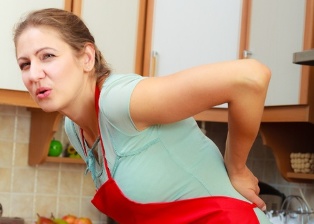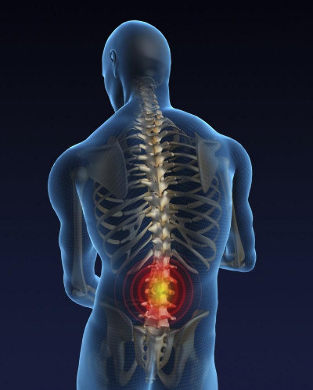In some cases, the patients, it is difficult in a standing Position straighten up. Acute back pain take a few days to several weeks.

Causes for acute back pain
Most people experience at least once in a lifetime pain in the back. Although pain or discomfort may occur at any level, most commonly the lumbar Region are affected. This happens because the lumbar is forced, the weight of the entire body and head.
Back pain is the second most common reason to see a doctor, what cold and flu.
In General, for the first time, a sharp pain in the loin will appear after lifting heavy objects, sudden movements, injury, or prolonged sitting in one Position.
Acute pain in the lower back, most often the result of a sudden trauma to the muscles and ligaments of the spine, herniated discs of the lumbar spine. Pain, in such cases, it may be due to a muscle cramp, strain or tear of the muscles and ligaments.
The causes of severe pain in the lower back include:
- Compression fractures of the spine due to injury or osteoporosis;
- Muscle spasms (excessive tension of the muscles);
- Hernia;
- Sciatica;
- Stenosis (narrowing) of the spinal canal);
- Curvature of the spine (eg scoliosis or kyphosis), including Morbus Scheuermann-Mau;
- Strain/tear of the muscles or the ligaments of the back;
- Spondylosis;
- Spondylolisthesis;
- Infection of the spine (discitis, abscess.
Acute back pain can also cause the following diseases:
- diffuse disease of connective tissue;
- Ankylosing Spondylitis;
- a malignant Tumor in the spine;
- rheumatoid Arthritis.
Causes of acute pain in the lower back, the back in connection with the problems in the spine or tissue:
- abdominal aortic aneurysm;
- Diseases of the gastro-intestinal tract: pancreatitis, stomach ulcer, cholecystitis;
- Herpes zoster;
- Diseases of the pelvis: endometriosis, Prostatitis, Adnexitis;
- Disease of the retroperitoneal space: renal colic, Pyelonephritis;
- Pregnancy.
Symptoms
The symptoms of acute lower back pain can vary significantly depending on the cause. You can experience numbness, tingling, the type of pain may be different, as well as the severity of the pain: from mild discomfort to pain that can hardly be endured. In addition, the cross combined with pain in the foot, hip, foot pain is often. In some cases, a weakness in the legs may.
Here are some examples of symptoms characteristic of various diseases and conditions:
- in the case of a ruptured disc, rupture: pain in the lower back, groin, often in the legs, where the pain is worse in the leg more pain in the back and sitting or after sleeping. Lower back pain can give in the buttocks, thighs and the descent over the leg to the foot. Occur, tingling, numbness in the legs and toes, in rare cases, the weakness of the muscles of the legs;
- when stretching the muscles of the loin: diffuse pain in the lower back, not in the leg or buttocks; worse on motion, and diminished in the rest state;
- if spinal stenosis: pain in the lower back and leg, the pain in the leg is stronger hernias lower back pain, such as spinal stenosis is often accompanied by the development of foramina; are amplified and weakened, go in peace and with a bent back. The pain can be unidirectional and bidirectional;
- in the case of diffuse connective tissue disorders: pain in multiple joints, fever, weight loss, weakness;
- Osteomyelitis: constant pain, often a reference temperature; blood picture in the standard, increased erythrocyte sedimentation rate (ESR) and/or the level of C-reactive Protein.
Diagnosis
On the consultation, the doctor will have a conversation with the patient, by completing the questions on the type and severity of pain and other symptoms, collect information about the patient's medical history and a physical examination. On the basis of the data of the interview and the examination, the doctor can make a diagnosis or a provisional diagnosis, must confirm and/or clarify with the help of medical Tests. Medical Tests can be different, starting with the blood tests to studies of nerve conduction. The most popular investigation include:
X-rays

X-ray recording was carried out to assess the condition of the bone of the patient. Diagnosis, which you with the help of an x-ray, osteoporosis, compression fracture, and bony outgrowths (osteophytes);
Magnetic resonance imaging (MRI)
The advantage of MRI over other studies is that using MRI, you will receive high quality detailed images of not only bone but also soft tissues: muscles, ligaments, vessels, nerves, intervertebral discs, spinal cord, etc.
The most common diagnoses according to findings of MRI:
- foramina hernia;
- Narrowing (stenosis) of the spinal canal;
- Spondylitis.
Other diagnoses, the one with the MRT:
- ankylosing Spondylitis (a type of Arthritis);
- Infection of the bone;
- Cauda equina syndrome;
- compression fractures;
- discitis (inflammation of the intervertebral disc);
- Abscess of the spinal cord;
- Damage to the spinal cord;
- Tumor in the spine.
Computed tomography (CT)
Computed tomography also allows you to take pictures not only in bone but also the soft parts, but the image quality is much worse than the quality of the recordings in the implementation of MRI, so CT is recommended, if the implementation of the MRI for some reason impossible or difficult, for example, in the case of a pacemaker or metal structures in the body.
Treatment
What you can do at home pain acute low back?
- Restriction of physical activity for 1-2 days. This will help alleviate the symptoms and lessen the inflammation in the painful area;
- the laying of hot-water bottles or bladder with ice to the painful area;
- Taking over-the-counter painkillers. Do not take this medication in larger amounts, as indicated in the instructions, the drugs do not more than 3 days. If during this time, the pain does not go away - the doctor must go.
During sleep it is better, the Position of the embryo, and put a pillow between the feet. If you got used to sleeping on the back, under the knee a pillow or towel rolled up on the back relieve.
If the cause of pain in the lower back is severe, the Patient needs a specific treatment depending on the disease or condition, causing painful sensations, and since you can without the help of experts
One of the most common causes of acute pain in the lower back, which requires a special treatment, intervertebral hernia. The treatment of a hernia, in General, conservative, only occasionally, the doctors have recourse to surgical methods. There are a large number of conservative methods of treatment of a hernia. Here are just a few of them are:
- The drug treatment. The drug treatment includes taking pain killers and anti-inflammatory drugs.
- Traction of the spine. Such an extension does not lead to complications in comparison with traction on the tables with a vector load or loads. Traction of the spine allows, in part, eat again, and, as a result, the condition of the intervertebral discs, and contributes to the reduction in size of a hernia;
- Therapeutic Massage. Types of medical treatments are different. Overall, this method is aimed at relaxation of the muscles of the back, the decrease in the muscle cramps, often accompanied by pain in the lower back;
- Healing gymnastics. Physiotherapy aims to strengthen the small muscles of the back;
- Leech therapy
Leech therapy relieves inflammation around the hernia pain syndrome reduces. Is an Alternative to painkillers. - Surgical Treatment. The surgical treatment of a hernia, it is recommended that only patients, not helps, the treatment with conservative means, provided that this treatment was carried out regularly and systematically, as well as patients, with the treatment with pronounced symptoms of neurological deficit: weakness in the legs, paresis, paralysis of the legs, numbness in the groin area, in violation of the monitoring of the functions of urination and/or defecation. All of the above symptoms are indications for urgent surgery on the spine.



























